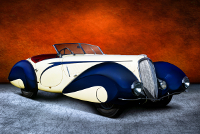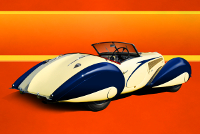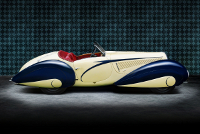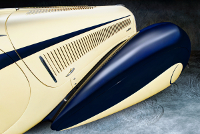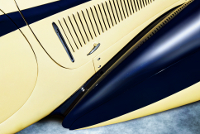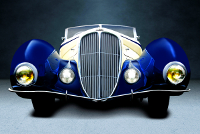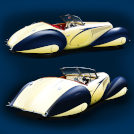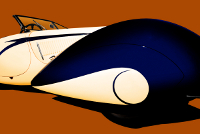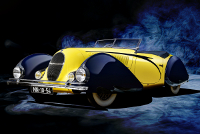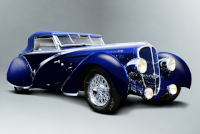Location:
St. Michaels Concours d'Elegance, 2012
St. Michaels Concours d'Elegance, 2008
Prologue:
We first met this car in 2006, where it sat next to the famous torpedo-bodied Talbot-Lago Darracq #90019 by Figoni et Falaschi. Two appearances at St. Michaels later offered a few catch-up shots, but I will say it's been a struggle to pull something good out of the stock. The main perspective from 2012 (1) required iteration after iteration to balance the color and light with a decent environment, whereas the profile from 2008 (3) worked alright from the start. The Hawaiian-style tail perspective (2) doesn't bother to control the sunlight from what was a beautiful summer day on Maryland's eastern shore, though I like the outcome. E also got into the action. She's got a completely different take on how to aim a camera, and back then liked experimenting with the super-wide angle lens (8), and that works well with an illustrative processing approach.
The late Malcolm Pray was very active with his outreach programs toward the end of his life, though we don't see many of his automobiles today. Though his foundation contacted me about images during the previous incarnation of this project, I did not consider my pictures so great at the time, and felt iffy about handing them out. This gallery looks a little bit better, though still inferior to what could be. But as the course continues, I develop 12cylinders for free public use and no longer begrudge inquiries.
- - - - - - - - - -
► Image Source: Nikon D200 (10.2 MP) | Image 7 finished at 15 MP to accommodate two perspectives.
Image Source 8 by E, illustrated by the author
References:
- Adatto, Richard. "Figoni on Delahaye" Dalton Watson Fine Books, Deerfield, IL. 2023, page 71, 93, 103
- RM Auctions: The auction house sold chassis #48667 in 2014, along with 16 other classics from Malcolm Pray Jr.'s collection.
- Autoblog: This article provides RM promotional copy, different from the catalogue entry above, and also the most extensive gallery of images online.
- UltimateCarPage: A small feature on both of the original Competition Court Torpedo Roadsters, by Wouter Melissen, March 12, 2014.
The torpedo roadster is perhaps the most noteworthy of many ostentatious Figoni et Falaschi roadsters. But the design itself fell into contestation by Geo Ham, born Georges Hamel, a French illustrator whose eye for depicting motion we now think upon as classically representative of Art Deco style. Ham threatened a lawsuit over a conspicuous lack of credit for his ideas, claiming that he had drafted concept sketches for what became the first torpedo roadster, chassis #47247, which debuted at the 1936 Paris Motor Show. However, Figoni's shop had already begun building chassis #47247 to Figoni's own design before Ham engaged Figoni for his own wants. Ham's project was to be a Delage coupe, not a Delahaye. And in their initial consultation, Figoni showed Hammel numerous designs of this type. Nevertheless, when #47247 appeared in Paris, Ham laid claim.
Richard Adatto makes clear that Giuseppi Figoni neither consulted with nor needed Geo Ham's contributions for the first torpedo roadster. One should readily agree, considering the catalogue of similarly shocking Figoni et Falaschi designs. Rather the extent to which Figoni took influence from the advertising pages on which Ham illustrated so many speedy visions is a matter that seems beyond the scope of fabrication, (merely illustration). And this distinction mattered in the court of law.
In the end, Ham lost his case, claiming to have overseen the torpedo's development when he was clearly not involved. The French court dismissed the case against Figoni. But evidence of the conflict lingered, most notably in this car, chassis #48667.
During the early stages of the lawsuit, Figoni agreed to pay Ham 500 francs for every car bodied in this style, and to affix a plate on the car naming Ham the designer. In so doing, Figoni and Delahaye avoided seizure of #47247 and production continued on the series. (Ham ran so quickly to his lawyers and the press that Figoni found himself served on the Paris show stand.) Chassis #48667 is the only car to retain the concessional Geo Ham design plate, as Figoni finished the car after the initial compliant, but before the court dismissed the case. The plate appears behind the door, tucked tight to the rear skirt, and it reads: "Creation Figoni-Falaschi-Geo Ham modele depose No. 7."
Adatto notes that we have eagerly swallowed the much-publicized origin story based on Geo Ham's account. And being an advertising man, Ham was keen to push his narrative, wanting to show the world a car of his design. So his story won out mainly by virtue of press coverage—a loud voice virtually unchallenged by the wronged party. (And not dissimilar to today's fake news phenomena.) Yet I do sympathize with Ham's position, if not factually then purely in an emotional sense. He was an artist who shared the same Modernist visions as Giuseppi Figoni and Alexis de Sakhnoffsky, though his influence remained strictly informal, restricted to the world of fictional cars rather than commissioned builds. So he felt entitled to share the credit, just did not realize that his share was not equal to his peers.
As to the design, the two defining features of the cabriolet torpedo are, first, the fully enclosed fender pods, which Figoni described as "enveloppantes," and second, the French curve as a body styling device. Together with the elliptical paint overtop the wheels and the era's requisite dorsal fin, these features were popularized through printed media in the years of the Figoni-Ham conflict. But Figoni et Falaschi brought these lines to life on the right chassis with the correct proportions.
According to RM Auctions, it is possible Delahaye commissioned chassis #48667 for themselves. No owner was listed, and the car was retained by the factory. Noting that the motor is the high-compression MS specification, RM also suggest that it was the factory to have made the upgrade in 1939, as the motor still wears matching numbers. Various sites and sources will often list this car as a 135 M, and that isn't far from correct, either. Chassis #48667 was originally stamped as a 135 M, though strictly speaking it is a non-production model.
Chassis #48667 came to New York later in 1939, where it was displayed at the World's Fair in Flushing Meadow. Photographer Bob Grier purchased this car from the show stand, along with a Delage D8-120 Cabriolet Deltasport. In the post-War years, Grier made steady use of the car as a hill-climb special. RM report that Grier and his Delahaye were photographed at speed from 1947 to 1950, appearing in Road & Track, MoToR, and Motor Trend magazine. To keep the car in fine fettle, Grier purchased a stock of spare parts directly from Delahaye in 1948. He kept the car until 1963.
In 1964, one Malcolm Pray, Jr. visited a used car market on Jerome Avenue near High Bridge in Brooklyn. There he found chassis #48667, now painted red and black. Remarkably, Mr. Pray had seen the same car at the New York World's Fair in 1939. During that first encounter, Pray was eleven years old, but already keen enough on automobiles to have fallen for the design, sketching it out afterward. He kept the sketch, and—red and black livery notwithstanding—recognized the car 25 years later.
So it was that the late Mr. Pray came to own one of the finest examples of the Figoni-bodied Delahaye—not through recognition of provenance or obsession with market value, but by the genuine affectations of childhood wonder. Like the car's previous owner, Malcolm Jr. also enjoyed the car for its sporting character and open touring potential, driving it well on weekends and vacations for 30 years. Not until 1994 did the car attend concours events, but even so it remained a runner first, and a show car second.
Motor: 3,557 cc straight 6-cylinder, cast-iron block and hemi-head | 84 mm x 107 mm | 7.0:1 compression
Valvetrain: OHV, 2 valves per cylinder
Aspiration: triple Solex 40 FILP carburetors
Power: about 125 bhp @ 4,000 rpm
Drivetrain: 4-speed manual gearbox, rear-wheel drive
Front Suspension: transverse semi-elliptic leafsprings with top links, and transverse Rafex friction dampers
Rear Suspension: live axle with quarter-elliptic leafsprings and transverse Rafex friction dampers
Architecture: steel ladder frame chassis with aluminum coachwork by Figoni et Falaschi
Wheelbase: 2,700 mm (106 inches)
Top Speed: 160 km/h (about 99 mph)
Etymology:
The Delahaye 135 is a sporting derivative of the well-to-do 138. I could be wrong, but the designation might involve differences in the front and rear track—I remember once reading something to this effect, and cannot locate anything conclusive at the moment. 'Competition Court' refers to the shortened chassis, which is 250 mm shy of the 2,950 mm wheelbase of the Delahaye 138. This 2,700 mm wheelbase chassis is essentially a 135 S, the version prepared for racing. 'Torpedo Roadster' fits the body description, a streamlined, open-top car with wheels fully enclosed. Figoni et Falaschi provided the coachwork. Chassis #48667 has been added to the name as well, though the designation is traditionally written as, '48.667.'
Figures:
Most sources state that about 30 Delahaye 135 Competition Court chassis were produced. Notably, the Competition Court was not an official model, and was produced in rather ad hoc fashion for about two years. Parallel to the special run of Competition Court cars, Figoni et Falaschi bodied eleven various chassis in this highly stylized coachwork; these were of long and short chassis, closed and open bodies. Of those eleven cars, at least three original Competition Court Torpedo Roadsters survive. The first, #47247 has been restored to a rolling chassis thus far. The other complete car is the ghost-grey and burgundy example restored by Jacques Harguindeguy in the 1990s. That car, #48666, is the sixth chassis of the lot. This car here, #48667, is the seventh. Within that lot of eleven cars, the sixth, seventh, and eighth cars were those set apart in an agreement between Figoni and Geo Ham owing to the latter's claim to the design. Only #48667 retains its Geo Ham design plate, Figoni's concession to the claimant, which lasted only until the French court threw out Ham's case.
Value:
Chassis #48667 sold in early 2014 for $6.6 million.
Chassis Comparison: Differences between Original Competition Chassis #48666 and #48667
Visual differences between #48667 and its sister car, #48666, include the addition of a faux fuel filler caps on the driver's side of the rear deck, and the brass Geo Ham plates located just aft of the doors, inside the rear fenders. Contrarily, chassis #48667 does not exhibit the chrome trim and rear marker lights found inside the fenders of #48666. This omission I find pleasing, as the cleanliness of the pod shape stands out with the contrasting paint. The front guards are much different between the two; the guard on this seventh car hugs the body and follows the vee of the grille, while the guard on #48666 is rather straight. And the tonneau cover is also a bit different between the two cars, although so much as most people have seen, Malcolm Pray, Jr. was not one to take the car out in public with the top up.
Color Evolution: Changing Livery on Delahaye Torpedo Roaster #48667
As to the color, the car was originally navy and ivory. Under Bob Grier's ownership, the livery was reversed. Before its sale to Malcolm Pray, Jr., chassis #48667 was red and black. Mr. Pray chose blue monaco and straw yellow upon restoring the car.
Figoni Design: French Curves and Italian Futurist Concepts Realized in Steel
Note how the dart on the top edge of the French curve motif fits nicely with the cut-down line of the door. Also note how the lower curve of the motif blends easily into the lower edge of the door.
Figoni drafted the shape in profile and in quarter perspective, showing a brilliant understanding of proportion. The shortened 135 Competition Court chassis is perfect for the distribution of bold curves and elegant pods. If anything more can be said, it would be that the front is deliberately grabbing. This mode of thinking—in which an evocation of motion is hammered out in aluminum—throws the forward points of the car far ahead of the grille. Then on the wheel skirts, the elliptical swirls keep the progressive concept moving, and from behind the whole composition seems to still peel itself forward. Overall, the Torpedo Roadster is a beautifully optimistic design, a car built for races of the mind rather than of the road.
Last Updated: Mar 26, 2025

